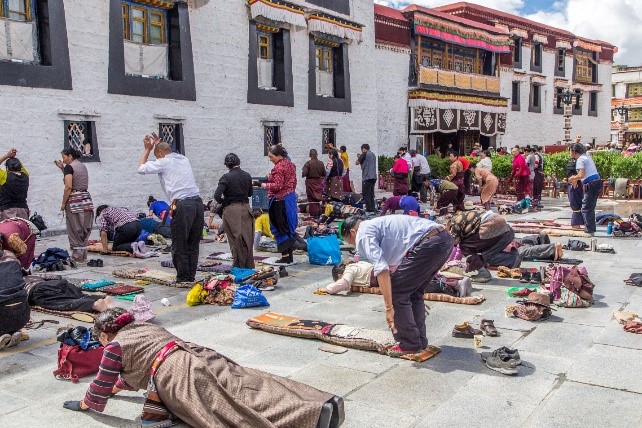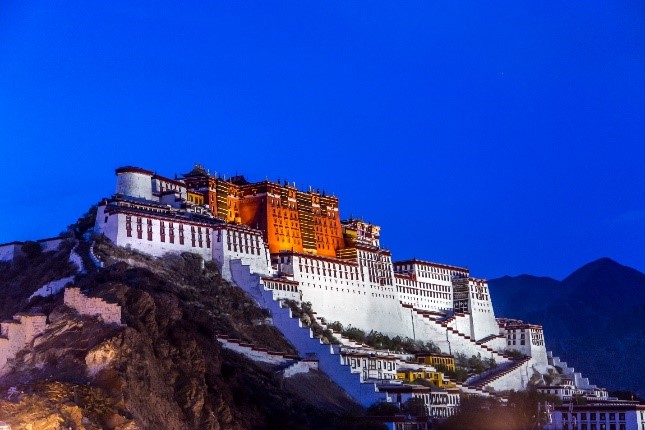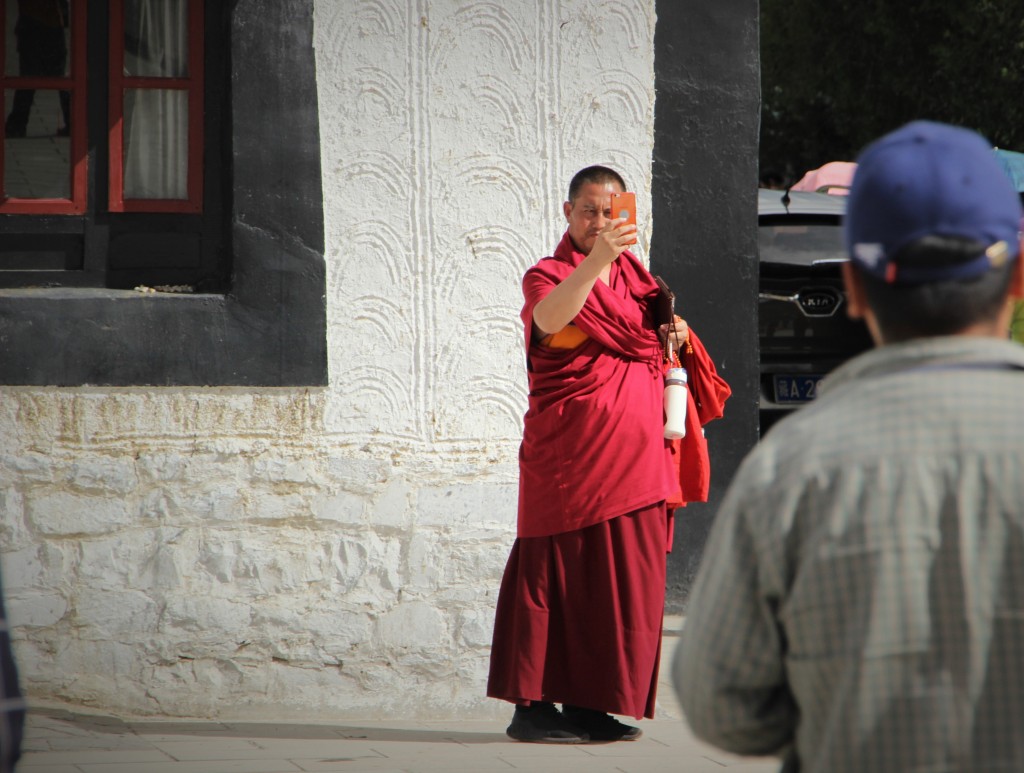Seven Days in Tibet: Tech and Spirituality in the Roof of the world
Seven Days in Tibet: Tech and Spirituality in the Roof of the world


On a recent trip to Tibet, Heyokha team had the opportunity to see how things are in one of China’s most remote and desolated areas. It turned out reality was quite different from what we were expecting.
Hidden on the highest plateau in the world, Tibet is known as being the home of golden monasteries and imposing mountain ranges. For most visitors Tibet’s attractions will be of a spiritual nature: secluded sceneries, chanting monks in temples and local pilgrims whispering mantras while turning their prayer wheels and prostrating themselves. It is captivating, inspiring and boundlessly photogenetic.

This is what people write about after their travels, what is posted on Instagram and it is also how Tibet is depicted in movies, etc. It is true, Tibet has such a level of piety and faith that it seems to belong to an earlier, almost ancient age. Yet, this is a one-sided view of the region that has shown double digit GDP growth (!) for the past 24 years .
Our own mystic and spiritual view of the country was eagerly satisfied by our Tibetan tour guide, who welcomed each of us with a Khata, the white Tibetan scarf that symbolises purity and compassion. We consumed all of the brochure-promised experiences, until we found ourselves dumbfounded by an otherwise perfectly mundane act. It was the sight of a monk flipping out his smartphone…

We came to realise it kind-of “troubled” us to find the supposedly traditional and spiritual Tibet being ‘polluted’ and made ‘inauthentic’ by such modernity. Of course, we realise such feelings are totally misplaced – after all, who are we to decide that Tibetans are to refrain themselves from the comforts of modern life? But experiencing that brief moment of discomfort – when reality bashes into misconception – is a valuable lesson.
Our reaction highlights that certain narratives perpetuate, even long after reality has changed. Apparently, this is a popular topic among anthropologists, some of whom are of the view that promotional efforts by both governments and the tourist industry capitalise on one-sided histories and imaginaries of countries and places, and thus keep such narratives alive.
As investors are only human, we are certainly not immune to these biased and outdated narratives in our investment decisions. The remedy for this is obviously to go see things for yourself – Heyokha style.
“You know nothing, John Snow…”
Wise words spoken by a barbarian lady to a future King.
One of the things that surprised us the most, is the extent to which Chinese tech companies managed to penetrate such remote area characterised by tradition and spirituality. Here is what caught our attention:
QR Code Stickers

We saw many shops in Tibet accepting Alipay and WeChat Pay, even the shops located in monasteries. Extrapolating from our observation that QR codes have penetrated most corners of Tibet, we think that the penetration across other Chinese rural and suburban areas must be very high as well.
As such, we feel that while online payments still “only” make-up about 20% of all payments in China, it represents not a “work in progress” but rather the population racing to catch up to a technology that is here to stay.
Food delivery apps

With altitude-induced headaches making the thought of leaving our hotel rooms a herculean challenge, food-delivery apps such as Meituan proved to be one of the most useful apps during our stay in Lhasa and Shigatse. Not only did the app give us access to delicious food, it also secured our supply line to much needed painkillers and oxygen cylinders.
With such a strong footprint across the various regions in China and expected growth of China’s online food and grocery delivery market, we will be keeping a close eye on Meituan Dianping’s $ 60bn planned IPO.
Bike sharing apps

2017 was the year of Bike Sharing in China. During our trip, the yellow bikes of bicycle sharing company ofo emerged everywhere, even in Tibet. To see how the company rolled out its operations to such remote areas is very impressive. The bikes are being used by all kinds of people ranging from kinds to grandpa’s and students to monks. Unfortunately, we didn’t dare to try to book and ride the bikes, anticipating further oxygen deficiencies…
Wrapping it up:
Our views will always be shaped by narratives. For us, our Tibet experience confirms that seeing things on the ground is essential in recognising what is usually not being told. While modernity in China may be associated with metropolitan cities like Shanghai and Beijing, it became clear to us that the reach of its tech giants goes all the way into the remote regions, albeit perhaps in part driven by Chinese tourism. With tech manifesting in Indonesia as well, we should not be mistaken to think that the tech revolution in Indonesia will be limited to its major cities.
Admin heyokha
Share
On a recent trip to Tibet, Heyokha team had the opportunity to see how things are in one of China’s most remote and desolated areas. It turned out reality was quite different from what we were expecting.
Hidden on the highest plateau in the world, Tibet is known as being the home of golden monasteries and imposing mountain ranges. For most visitors Tibet’s attractions will be of a spiritual nature: secluded sceneries, chanting monks in temples and local pilgrims whispering mantras while turning their prayer wheels and prostrating themselves. It is captivating, inspiring and boundlessly photogenetic.

This is what people write about after their travels, what is posted on Instagram and it is also how Tibet is depicted in movies, etc. It is true, Tibet has such a level of piety and faith that it seems to belong to an earlier, almost ancient age. Yet, this is a one-sided view of the region that has shown double digit GDP growth (!) for the past 24 years .
Our own mystic and spiritual view of the country was eagerly satisfied by our Tibetan tour guide, who welcomed each of us with a Khata, the white Tibetan scarf that symbolises purity and compassion. We consumed all of the brochure-promised experiences, until we found ourselves dumbfounded by an otherwise perfectly mundane act. It was the sight of a monk flipping out his smartphone…

We came to realise it kind-of “troubled” us to find the supposedly traditional and spiritual Tibet being ‘polluted’ and made ‘inauthentic’ by such modernity. Of course, we realise such feelings are totally misplaced – after all, who are we to decide that Tibetans are to refrain themselves from the comforts of modern life? But experiencing that brief moment of discomfort – when reality bashes into misconception – is a valuable lesson.
Our reaction highlights that certain narratives perpetuate, even long after reality has changed. Apparently, this is a popular topic among anthropologists, some of whom are of the view that promotional efforts by both governments and the tourist industry capitalise on one-sided histories and imaginaries of countries and places, and thus keep such narratives alive.
As investors are only human, we are certainly not immune to these biased and outdated narratives in our investment decisions. The remedy for this is obviously to go see things for yourself – Heyokha style.
“You know nothing, John Snow…”
Wise words spoken by a barbarian lady to a future King.
One of the things that surprised us the most, is the extent to which Chinese tech companies managed to penetrate such remote area characterised by tradition and spirituality. Here is what caught our attention:
QR Code Stickers

We saw many shops in Tibet accepting Alipay and WeChat Pay, even the shops located in monasteries. Extrapolating from our observation that QR codes have penetrated most corners of Tibet, we think that the penetration across other Chinese rural and suburban areas must be very high as well.
As such, we feel that while online payments still “only” make-up about 20% of all payments in China, it represents not a “work in progress” but rather the population racing to catch up to a technology that is here to stay.
Food delivery apps

With altitude-induced headaches making the thought of leaving our hotel rooms a herculean challenge, food-delivery apps such as Meituan proved to be one of the most useful apps during our stay in Lhasa and Shigatse. Not only did the app give us access to delicious food, it also secured our supply line to much needed painkillers and oxygen cylinders.
With such a strong footprint across the various regions in China and expected growth of China’s online food and grocery delivery market, we will be keeping a close eye on Meituan Dianping’s $ 60bn planned IPO.
Bike sharing apps

2017 was the year of Bike Sharing in China. During our trip, the yellow bikes of bicycle sharing company ofo emerged everywhere, even in Tibet. To see how the company rolled out its operations to such remote areas is very impressive. The bikes are being used by all kinds of people ranging from kinds to grandpa’s and students to monks. Unfortunately, we didn’t dare to try to book and ride the bikes, anticipating further oxygen deficiencies…
Wrapping it up:
Our views will always be shaped by narratives. For us, our Tibet experience confirms that seeing things on the ground is essential in recognising what is usually not being told. While modernity in China may be associated with metropolitan cities like Shanghai and Beijing, it became clear to us that the reach of its tech giants goes all the way into the remote regions, albeit perhaps in part driven by Chinese tourism. With tech manifesting in Indonesia as well, we should not be mistaken to think that the tech revolution in Indonesia will be limited to its major cities.
Admin heyokha
Share














